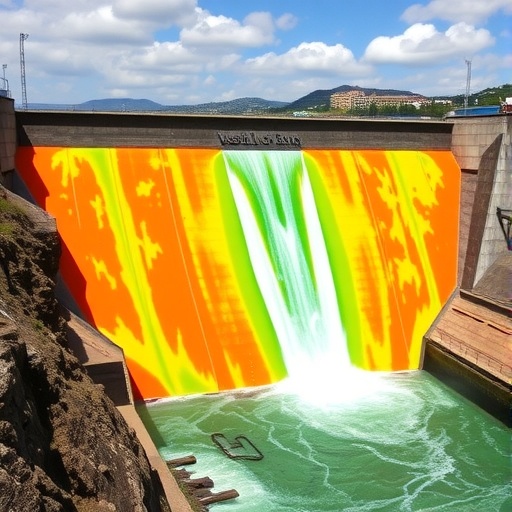In an era where water scarcity and sustainable resource management have become paramount global challenges, groundbreaking innovations in hydrological modeling are emerging as vital tools to secure water futures. A recent study, focusing on the Bartın Bahçecik underground dam in Turkey, embodies this trend by harnessing the power of machine learning integrated with conventional hydrological models to estimate streamflow with heightened accuracy. This pioneering approach not only propels the science of underground dam management forward but could also serve as a transformative blueprint for water resource engineers, hydrologists, and environmental scientists worldwide.
The study in question addresses a critical problem in hydrological science: accurately predicting streamflow in environments influenced by underground dam infrastructure. Underground dams, also known as sub-surface dams, are subsurface barriers constructed to intercept and store groundwater or baseflows in riverbeds, enhancing water availability, particularly in arid or semi-arid regions. Despite their widespread use, traditional streamflow estimation around these structures is fraught with challenges due to complex subsurface hydrodynamics, spatial variability, and limited observational data. Conventional hydrological models, while effective in many contexts, often struggle to capture these nuanced interactions, leading to significant uncertainties in water management decisions.
Leveraging the latest advancements in machine learning, Ekemen Keskin and Şander have developed a hybrid modeling framework that integrates data-driven algorithms with physical hydrological models to surmount these challenges. Their methodology involves training machine learning models—capable of discerning subtle patterns and nonlinear relationships—from historical hydrological and meteorological datasets collected at the Bartın Bahçecik site. By incorporating variables such as precipitation, temperature, soil characteristics, and streamflow records, the model dynamically learns to forecast streamflow with improved temporal and spatial resolution, a critical feature for optimizing underground dam operations.
What distinguishes this research is its rigorous coupling of machine learning with hydrological principles, creating synergy between data-based insights and established scientific understanding. Rather than replacing traditional models, the machine learning components function as adaptive agents that refine predictions based on real-time data, enhancing model responsiveness to environmental fluctuations. This fusion addresses longstanding limitations in groundwater flow simulation accuracy, particularly in complex terrains characterized by heterogeneous subsurface geology and variable climatic conditions.
The choice of the Bartın Bahçecik underground dam as a case study is particularly noteworthy. Situated in a region where water availability is seasonally constrained, the dam plays a pivotal role in local water supply and agricultural irrigation. Accurate streamflow estimation here is critical to prevent over-extraction, maintain ecological balance, and inform sustainable water resource planning. The study’s outcomes demonstrate that the integrated modeling approach significantly outperforms standalone hydrological models, delivering predictions that closely align with observed streamflow measurements across different seasonal cycles and hydrological events.
Beyond the practical implications for water management, this research opens new avenues for addressing one of the most pressing environmental concerns of our time. Improved streamflow estimation aids in anticipating drought conditions, managing flood risks, and optimizing groundwater recharge strategies—factors essential to climate resilience and ecosystem health. The ability of machine learning to adapt to changing climate patterns, by recalibrating forecasts with fresh data inputs, makes it an indispensable tool in a world where hydrological regimes are becoming increasingly unpredictable.
Moreover, the study illustrates the transformative potential of interdisciplinary collaboration between hydrology and data science. By employing advanced algorithms such as neural networks, random forests, or gradient boosting machines within the framework of hydrological modeling, the researchers exemplify a paradigm shift towards smarter, more responsive environmental monitoring systems. This integrated approach could revolutionize how underground dams and other water infrastructure projects worldwide are planned, monitored, and managed.
The findings also underscore the importance of high-quality, continuous hydrological data as a foundation for machine learning applications. Effective model training and validation depend on comprehensive datasets that capture the variability and stochastic nature of hydrological processes. The Bartın Bahçecik project benefited from state-of-the-art monitoring networks providing detailed temporal records, highlighting the need for investment in data acquisition technologies to fully leverage machine learning in hydrological contexts.
Interestingly, the study tackles the inherent uncertainties in groundwater modeling by quantifying prediction confidence intervals and error metrics, fostering greater trust in model outputs among stakeholders. The researchers emphasize transparency and interpretability, addressing common criticisms of machine learning as ‘black box’ methods. By integrating physical constraints and domain knowledge into model architecture, the approach balances predictive power with scientific rigor—a critical consideration for practical deployment in water resource governance.
In conclusion, the fusion of machine learning with hydrological modeling as demonstrated in the Bartın Bahçecik underground dam case study marks a significant advancement in streamflow estimation techniques. This innovative methodology offers a scalable, adaptable solution to enhance water resource reliability amidst climatic uncertainty and growing demand. As global water challenges intensify, such integrative, technology-driven approaches will likely become linchpins in sustainable water management strategies, driving both scientific understanding and practical impact.
This research not only sheds light on the hidden dynamics beneath our feet but also invites a reimagining of how artificial intelligence and traditional science can coalesce to safeguard one of humanity’s most vital resources. In a rapidly evolving environmental landscape, the ability to harness machine intelligence to decode complex natural systems may well define the next frontier in water resource science.
Subject of Research: Streamflow estimation for underground dams using machine learning integrated with hydrological modeling.
Article Title: Correction: Streamflow Estimation for underground dams using machine learning and hydrological modeling: a case study of Bartın Bahçecik underground dam.
Article References:
Ekemen Keskin, T., Şander, E. Correction: Streamflow Estimation for underground dams using machine learning and hydrological modeling: a case study of Bartın Bahçecik underground dam. Environ Earth Sci 84, 675 (2025). https://doi.org/10.1007/s12665-025-12681-8
Image Credits: AI Generated




